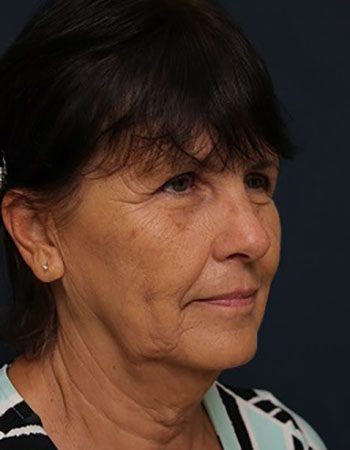Facelift in Weston, Florida
Our faces are essential tools for portraying emotions and expressing ourselves. However, it can be difficult to feel authentically yourself when aging signs have caused your face to not match your mood or align with how you want to present yourself. As we age, our skin produces less collagen and elastin and becomes thin, leading to lines and wrinkles. As the facial tissues lose elasticity and fat volume, the face begins to sag.
Facelift surgery can be an excellent option for people who wish to rejuvenate their faces. Dr. Messa performs facelifts in Weston, FL, to help patients reduce aging signs and restore confidence in their appearance.
What Is a Facelift?
A facelift, or rhytidectomy, is a popular facial rejuvenation procedure designed to lift and smooth your facial tissues. Drooping skin is corrected, and wrinkles are reduced to erase years from your appearance and enhance your facial contours. This surgical procedure involves creating incisions around the face, allowing the surgeon to reposition fat and underlying muscles, remove excess fat, tighten the skin over the face, and trim away excess skin.
What Are the Benefits of a Facelift?
Some of the benefits of facelift surgery include:
- Reduces facial sagging
- Eliminates the appearance of jowls (loose skin below the jaw)
- Smooths wrinkles and facial lines
- Achieves firmer, smoother, more youthful-looking facial contours
- Enhances confidence in appearance
Am I a Good Candidate for Facelift Surgery?
Facelift candidates may experience one or more of the following issues:
- Sagging and relaxation of the facial skin
- Deepening of fold lines around the nose and mouth
- Drooping cheeks
- Jowls along the cheeks and jawline
- Loss or displacement of fat in the face
Schedule your consultation with Dr. Messa at Weston Cosmetic Surgery Center to learn if you’re a facelift candidate.
What Is a Facelift Consultation Like?
Dr. Messa seeks to provide comprehensive care for each of his patients. In order to do this, Dr. Messa and his team will customize the consultation to fit your individual needs.
During your facelift consultation, you will:
- Meet the patient care coordinator, who will provide you with more information about the procedure
- Meet and become familiar with the Western Cosmetic Surgery Center team
- Undergo an examination by Dr. Messa
- Discuss your medical history, concerns, and goals with Dr. Messa, and he will ensure you have realistic expectations of what facelift surgery can do and that you are healthy enough for surgery
- See before and after facelift photos from other patients
If you are seen as a good candidate and are ready to undergo a facelift, Dr. Messa will create a custom treatment plan based on your facial anatomy and aesthetic goals.
How Much Does a Facelift Cost in Weston, FL?
Achieving natural, beautiful facelift results requires the skill and dedication of your surgeon, and the cost of your facelift may reflect this. The cost of each facelift procedure is decided on a patient-by-patient basis because many factors can affect the price. Since each facelift is customized, the techniques used will vary, which will contribute to the price. Location, surgical fees, facility fees, anesthesia fees, and medications for recovery can all impact the final price of your procedure. At Weston Cosmetic Surgery Center, we offer financing options with CareCredit®, Alphaeon Credit®, and Lending USA™ to help patients pay for their procedures.
What Is the Facelift Procedure Like?
At the beginning of the procedure, anesthesia will be administered to patients to allow for a comfortable experience. Next, Dr. Messa will create incisions around the face in the locations that were selected and agreed upon with the patient. Once the incisions are made, Dr. Messa will lift the skin up so he can access the underlying tissues. Dr. Messa will rearrange the fat and muscles to fit the patient’s desired facial contour; excess fat may be removed. After all necessary adjustments have been made, Dr. Messa will redrape the skin over the face and trim any excess skin to eliminate sagging. Once everything is in place, the incisions will be closed.
What Are My Facelift Options?
The techniques chosen to perform your facelift will depend on your facial anatomy and goals. During your consultation, Dr. Messa will make recommendations for which type of facelift will best suit your needs. Some patients may be good candidates for combination procedures with their facelift, such as adding liposuction to remove excess fat or a neck lift to allow for more comprehensive results between the face and neck.
Traditional Facelift
The traditional facelift focuses on improving signs of aging in the lower two-thirds of the face, from the cheeks to the jawline and the neck. Incisions are made in the hairline that extend from the temples down along the natural curvature of the ear in front to the earlobe and then along the crease behind the ear. The underlying muscles are adjusted through the incisions, and fat may be redistributed to restore fullness. Skin is redraped to highlight the new facial contours and excess skin is removed. The lifting and repositioning of the skin, muscle, and fat is performed in two layers.
Mini Facelift
The mini facelift focuses on improving signs of aging around the mouth, in the cheeks, and along the jawline. Limited incisions are made in front of the ear to the earlobe. The skin and muscles are adjusted, and the skin is redraped, similar to the traditional facelift. While the mini facelift addresses the deep tissue layers to provide long-lasting correction, it doesn’t address sagging in the neck. For this reason, patients with pronounced jowls and loose neck skin may not be ideal candidates for the mini facelift.
SMAS Facelift
The SMAS facelift addresses the lower two-thirds of the face, like the traditional facelift. SMAS refers to the superficial musculoaponeurotic system, which is the muscular layer of the face. This procedure tightens this muscular layer, redistributes underlying fat and muscles, and tightens the skin over the face.
Deep Plane Facelift
The deep plane facelift typically treats the region from the jawline to the corner of the eyes. The muscular face layer is lifted as one unit, allowing Dr. Messa to adjust the tissues underneath before pulling the skin back down.
Frequently Asked Questions
-
What should I do before my facelift surgery?
It is important to take some time to prepare for your procedure to support an effective surgery and recovery. In the time leading up to your procedure, you may be asked to undergo a medical evaluation, take or adjust certain medications, apply skin treatments or products, stop smoking, and avoid taking drugs that can increase bleeding. Maintaining your nutritional and physical health both before and after the procedure can help to enhance and maintain your results.
-
What type of anesthesia is used during facelift surgery?
Facelift surgery is performed with the patient under general anesthesia or intravenous sedation to ensure comfort and safety.
-
How long does facelift surgery take?
Most facelift surgeries take between two and three hours to perform, and the procedure is followed by a minimum two-hour recovery period at the facility. Facelift surgery is an outpatient procedure, and most patients may return home the same day. However, Dr. Messa prefers to monitor his facelift patients overnight in our facility to ensure patients receive optimal post-operative care.
-
How old do I have to be to undergo facelift surgery?
There is no minimum age required to undergo a facelift. If you have begun to experience the effects of aging and require surgical improvement, you can consider a facelift. Most patients who receive facelifts are between 40 and 60 years of age. However, in healthy individuals, a facelift can be performed on someone older.
-
Which facelift option is best for me?
The facelift technique that will best fit your needs is based on the severity of skin sagging and wrinkles as well as which areas of the face have these signs of aging. The best way to know which facelift option is best for you is to go through a consultation to get advice from your surgeon.
-
How long will my facelift results last?
While a facelift can rejuvenate your appearance and provide long-lasting results, your face will continue to age naturally. A facelift offers results that can usually be maintained for a long time with proper skin care and a healthy lifestyle. Most patients achieve facelift results that provide significant improvement for five to seven years.
Follow-up procedures such as skin resurfacing treatments, microdermabrasion treatments, and chemical peel facials can be used to extend the life of your facelift results.
-
What is scarring like after a facelift?
Incision scars from a facelift tend to be permanent but are discreet and can often be easily hidden behind the hairline. This can help to ensure natural-looking facelift results. Fading creams may be used if a scar seems especially prominent.
-
Will facelift surgery address my sagging neck?
Patients with moderate to severe facial sagging are more likely to experience drooping tissue on the neck as well. If left untreated, a loose neck appearance can negatively impact the quality of your facelift results.
While facelift surgery addresses the lower face and jawline, a neck lift (lower rhytidectomy) may be needed if you have drooping neck tissues. A secondary incision is placed discreetly under the chin. A platysma corset tightens loose neck muscles, and excess skin is removed. Liposuction may be used to eliminate excess fat.
The neck lift is designed to restore a slimmer neck appearance and enhance definition along the jawline. Improving the appearance of a “turkey” neck and “double chin” helps most people achieve the overall facial appearance they desire.
-
Can I combine my facelift with other procedures?
Yes. Fat grafting is often combined with facelift surgery to restore youthful volume to the face.
Patients with signs of aging in the upper face who would like to maintain their facial harmony generally opt to undergo a brow lift (forehead lift) and/or eyelid lift surgery (blepharoplasty) with their facelift.
-
Can I have a facelift without surgery?
Non-surgical facial rejuvenation with a “liquid facelift” is available for those who do not want to undergo a surgical procedure. A liquid facelift consists of using botulinum toxin injections like BOTOX® Cosmetic and dermal fillers like JUVÉDERM® and Restylane® injections to add volume to the face and smooth the skin.
While these non-surgical treatments can improve signs of aging like wrinkles and fine lines, the results are not as dramatic or permanent as a surgical facelift, and they cannot address significantly sagging skin.
Want to Learn More About Facelift Surgery in Weston, FL?
If facial sagging and wrinkles are bothering you, facelift surgery may be able to provide much-needed relief and transformative results. To learn more about facelifts or to schedule your consultation in Weston, FL, call 954-659-7760 or 877-250-8117 or complete our online contact form today.









